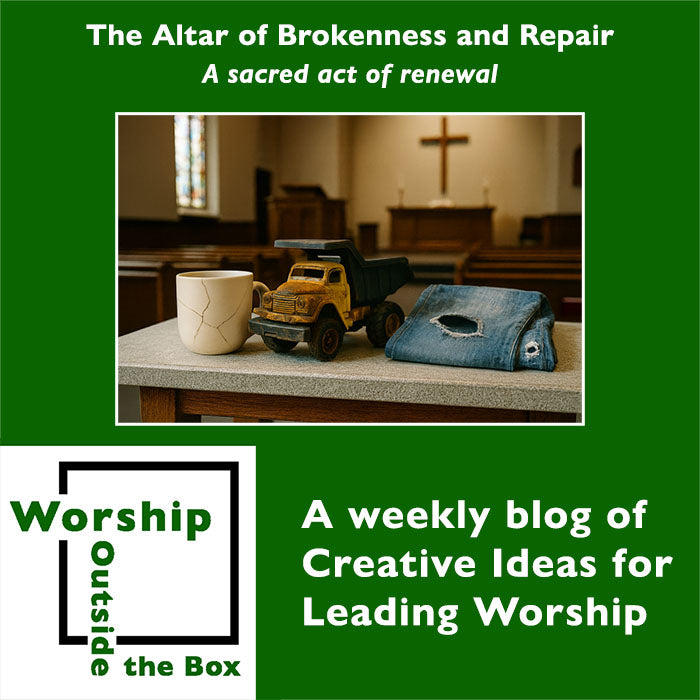
53 – The Altar of Brokenness and Repair
Share

A weekly blog of Creative Ideas for Leading Worship
The Altar of Brokenness and Repair

A sacred act of renewal
Purpose
To create a worship experience that honours brokenness as a sacred part of life and faith.
This activity invites people to bring broken household items to form an altar that symbolises God’s ongoing work of mending, healing, and transformation.
Theme
Mending our lives together – recognising that the cracks and fractures in our lives, communities, and world can become places where grace shines through.
The Big Idea
In a culture obsessed with perfection, this activity turns our attention to what is cracked, worn, and damaged. By bringing broken objects into the heart of worship, we remember that God’s love meets us not in our polish, but in our imperfection. Brokenness becomes sacred space, and repair becomes a prayer.
Preparation
You will need:
- A designated altar or display table covered with a plain cloth.
- Space around it for people to approach easily.
- A collection of broken household objects (or invite participants to bring their own): chipped mugs, cracked bowls, broken toys, torn fabrics, snapped pencils, etc.
- Repair materials: glue, thread, gold and other coloured paint, etc.
- Small ribbons, tags, or cards for written prayers or names.
- Soft background music or instrumental accompaniment.
Set the Scene:
Create an atmosphere of reflection and gentle reverence. Use natural light, candles, or warm tones to draw focus to the altar.
How to Lead the Experience
1: Introduction
Explain that the activity focuses on God’s transforming love that meets us in our brokenness.
Say something like:
“Today we bring our broken things – and our broken selves – before God. Here, at this altar of repair, we recognise that what is cracked is not worthless, but beloved.”
2: Bringing the Broken Pieces
Invite people to bring their broken objects to the altar.
As they come forward, encourage silence or play soft music.
Participants may:
- Place their objects gently on the altar.
- Whisper a short prayer for healing, reconciliation, or peace.
- Write a name or situation on a ribbon or card and attach it to an object.
3: Acts of Repair
Demonstrate simple acts of mending:
- Glue a piece together.
- Stitch a tear or hole.
- Paint a gold line over a crack.
Explain that this is symbolic of God’s work in our lives – not hiding what’s broken but transforming it.
“Like Japanese kintsugi pottery, the gold in the crack tells a story of restoration. Resurrection often begins in the rubble.”
4: Community Prayer
Gather the congregation around the altar.
Pray aloud in the style of intercessory prayer for:
- Healing in relationships and communities
- Wisdom and courage for leaders
- Compassion for those suffering
- Renewal for the Earth
Encourage brief silent prayers between petitions.
5: Reflection and Response
Invite people to look at the altar now filled with repaired and unrepaired items.
Reflect together:
- What do these objects say about our own lives?
- Where do we need God’s mending love?
- How might we take part in the repair of the world?
Closing Words
End with a short blessing:
“God of all things broken and beautiful, teach us to love what is imperfect, to mend what can be healed, and to carry hope in the cracks that remain. Amen.”
Reflection
The completed altar, filled with chipped, torn, and restored objects, stands as a parable of grace. Some items gleam with repair; others remain incomplete.
Together, they proclaim the truth of resurrection: that love never discards, and God always begins again.
Ngā mihi
Philip

1 comment
Beautiful – an inspiration for my MA Fine Art project